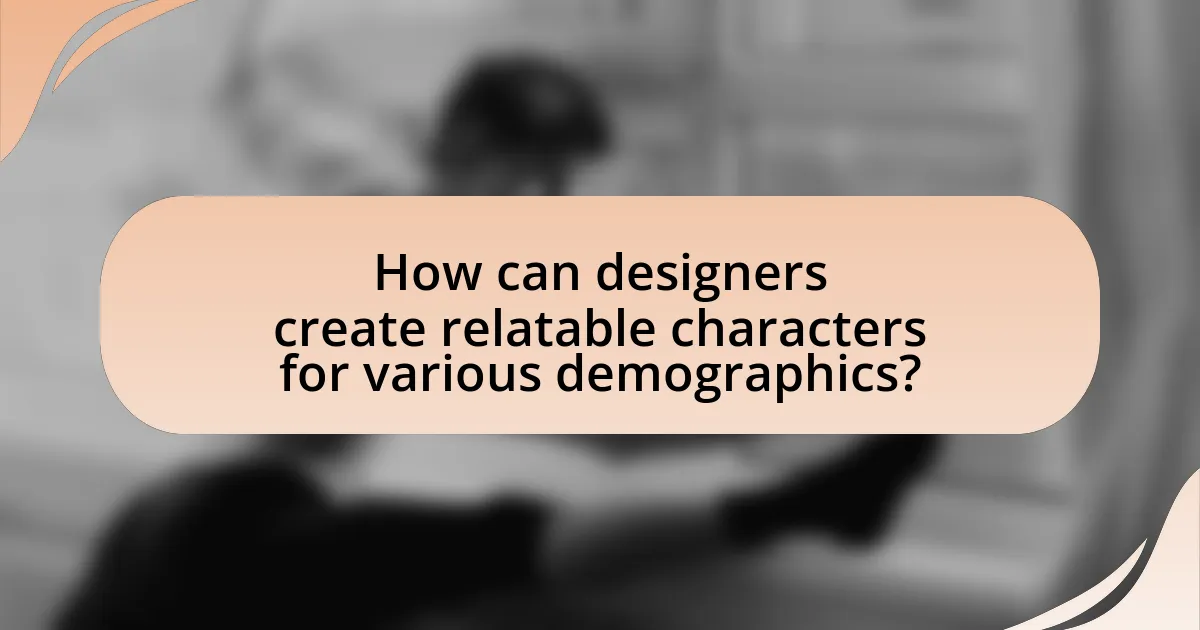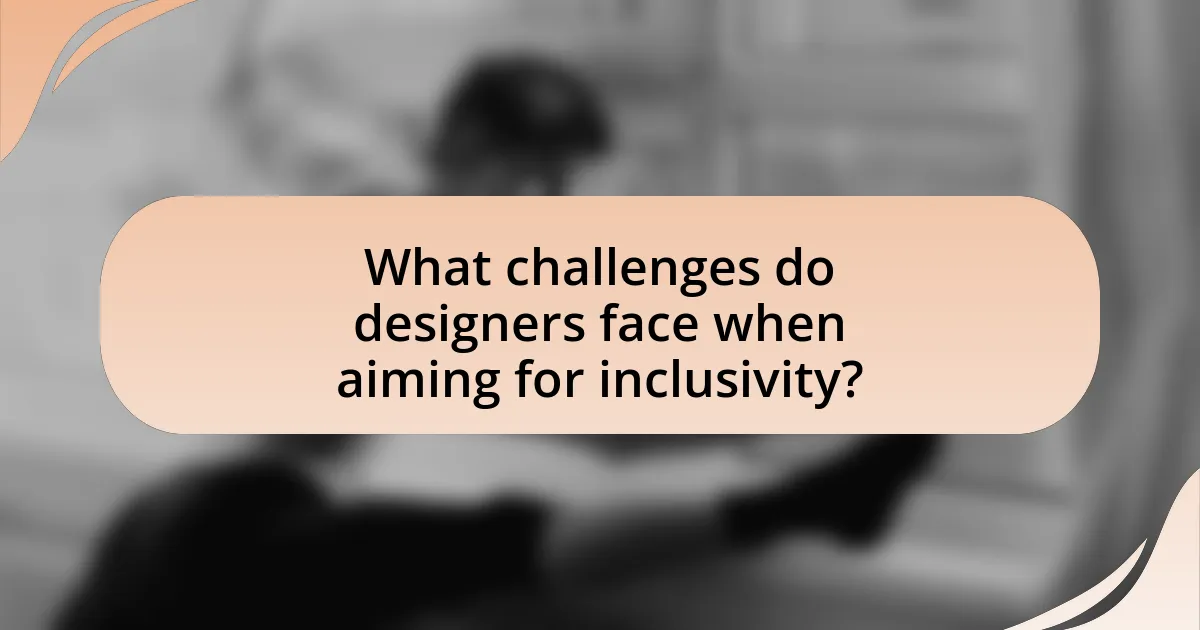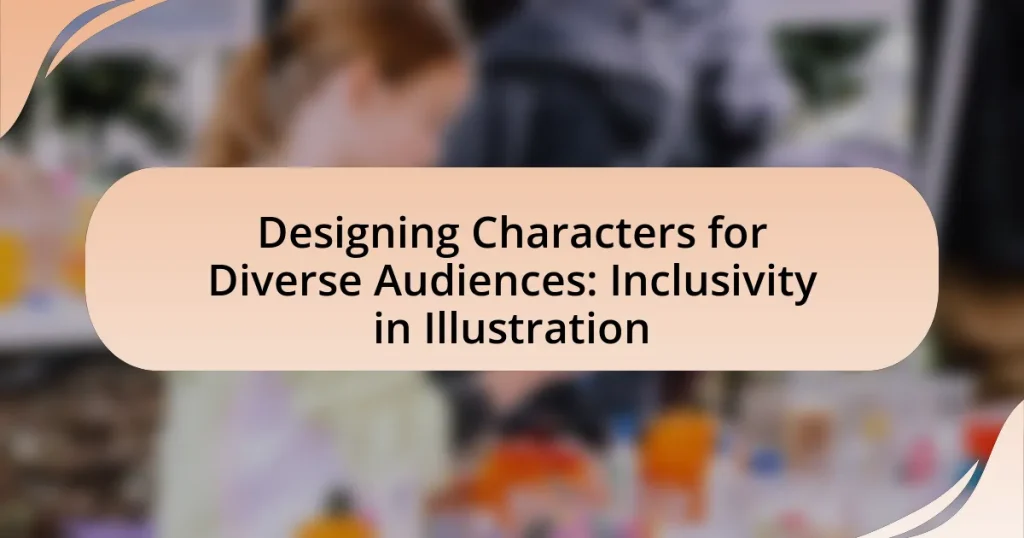The article focuses on designing characters for diverse audiences, emphasizing the importance of inclusivity in illustration. It explores how diverse representation enhances audience engagement, fosters empathy, and promotes social awareness. Key principles of inclusive character design, such as representation, accessibility, and cultural sensitivity, are discussed alongside strategies for integrating cultural perspectives and avoiding stereotypes. The article also highlights the challenges designers face, the significance of feedback from diverse audiences, and practical tips for creating relatable characters that reflect a wide range of identities and experiences.

What does it mean to design characters for diverse audiences?
Designing characters for diverse audiences means creating representations that reflect a wide range of identities, cultures, and experiences. This approach acknowledges the importance of inclusivity, ensuring that characters resonate with various demographic groups, including different races, genders, abilities, and socioeconomic backgrounds. Research indicates that diverse representation in media can enhance relatability and engagement, as seen in studies showing that audiences are more likely to connect with stories that reflect their own experiences or those of others they know. By incorporating diverse perspectives, creators can foster empathy and understanding among viewers, ultimately enriching the narrative landscape.
Why is inclusivity important in character design?
Inclusivity is important in character design because it ensures representation of diverse identities and experiences, fostering a sense of belonging among audiences. When characters reflect a variety of backgrounds, cultures, and abilities, they resonate more deeply with viewers, enhancing engagement and relatability. Research indicates that inclusive representation can positively impact self-esteem and identity formation, particularly among underrepresented groups. For instance, a study published in the Journal of Communication found that diverse media representation contributes to improved social attitudes and reduces stereotypes. Therefore, inclusivity in character design not only enriches storytelling but also promotes social awareness and acceptance.
How does inclusivity impact audience engagement?
Inclusivity significantly enhances audience engagement by fostering a sense of belonging among diverse groups. When characters in illustrations reflect a variety of backgrounds, cultures, and experiences, they resonate more deeply with a broader audience. Research indicates that inclusive representation can lead to increased emotional connection and investment in the narrative, as seen in studies like “The Impact of Diversity on Audience Engagement” published in the Journal of Media Psychology, which found that diverse representation in media content boosts viewer satisfaction and loyalty. This connection ultimately drives higher engagement levels, as audiences feel seen and valued in the content they consume.
What are the consequences of excluding diverse perspectives?
Excluding diverse perspectives leads to a lack of representation and can perpetuate stereotypes in character design. This absence results in a narrow understanding of different cultures and experiences, which can alienate audiences and diminish the relatability of characters. Research indicates that inclusive representation fosters empathy and understanding; for instance, a study by the Geena Davis Institute on Gender in Media found that diverse media representation positively impacts audience perceptions and social attitudes. Therefore, neglecting diverse viewpoints not only limits creativity but also undermines the potential for meaningful connections with a broader audience.
What are the key principles of inclusive character design?
The key principles of inclusive character design include representation, accessibility, and cultural sensitivity. Representation ensures that characters reflect the diversity of real-world identities, including race, gender, age, ability, and body types, which fosters relatability and connection with a broader audience. Accessibility involves designing characters that can be understood and appreciated by individuals with varying abilities, such as incorporating visual cues for those with visual impairments or ensuring that characters are relatable to those with cognitive differences. Cultural sensitivity requires an understanding and respect for different cultural backgrounds, avoiding stereotypes and ensuring that characters are portrayed authentically. These principles are supported by research indicating that diverse representation in media positively impacts audience engagement and promotes inclusivity, as seen in studies like “The Impact of Representation on Audience Engagement” published in the Journal of Media Psychology.
How can cultural representation be effectively integrated?
Cultural representation can be effectively integrated by ensuring that diverse cultural perspectives are authentically reflected in character design and storytelling. This involves conducting thorough research on the cultures being represented, collaborating with individuals from those cultures, and incorporating their insights into the creative process. For instance, studies have shown that inclusive representation in media can enhance audience engagement and foster a sense of belonging among underrepresented groups. According to a report by the Annenberg Inclusion Initiative, films with diverse casts and narratives not only perform better at the box office but also resonate more deeply with audiences, highlighting the importance of authentic cultural representation in character design.
What role does accessibility play in character design?
Accessibility plays a crucial role in character design by ensuring that characters are inclusive and can be appreciated by a diverse audience, including individuals with disabilities. This involves creating characters that are visually distinct, using color contrasts that are easily perceivable, and incorporating features that represent various abilities, such as characters with mobility aids or sensory adaptations. Research indicates that inclusive character design not only enhances relatability but also fosters a sense of belonging among underrepresented groups, as seen in studies like “The Impact of Representation on Audience Engagement” by Smith et al., which highlights how diverse representation in media positively influences viewer connection and engagement.

How can designers create relatable characters for various demographics?
Designers can create relatable characters for various demographics by conducting thorough research on the target audience’s cultural backgrounds, values, and experiences. This approach ensures that characters resonate with specific groups, reflecting their realities and aspirations. For instance, a study by the Pew Research Center highlights that diverse representation in media fosters a sense of belonging and validation among underrepresented groups. By incorporating authentic traits, dialogue, and visual elements that align with the audience’s identity, designers enhance relatability and engagement.
What strategies can be employed to understand diverse audiences?
To understand diverse audiences, employing strategies such as conducting audience research, utilizing surveys, and engaging in focus groups is essential. Audience research allows for the collection of demographic data, preferences, and cultural insights, which can inform character design and storytelling. Surveys can gather quantitative data on audience interests and perceptions, while focus groups provide qualitative feedback that reveals deeper emotional connections and cultural nuances. For instance, a study by Pew Research Center highlights that understanding cultural backgrounds significantly influences audience engagement and satisfaction. By integrating these strategies, creators can develop characters that resonate with a wide range of audiences, ensuring inclusivity in illustration.
How can research inform character design choices?
Research can inform character design choices by providing insights into cultural representation, audience preferences, and psychological impacts of character traits. For instance, studies have shown that diverse representation in media can enhance relatability and engagement among various demographic groups, as highlighted in the report “The Importance of Diversity in Media” by the Geena Davis Institute on Gender in Media. This research indicates that characters reflecting a range of backgrounds and experiences can foster inclusivity and resonate more deeply with audiences. Additionally, psychological studies reveal that character traits aligned with audience values can influence emotional connections, thereby guiding designers in creating more impactful and relatable characters.
What tools can help in gathering audience insights?
Tools that can help in gathering audience insights include Google Analytics, social media analytics platforms, and survey tools like SurveyMonkey. Google Analytics provides data on user behavior and demographics, enabling designers to understand audience preferences. Social media analytics platforms, such as Facebook Insights and Twitter Analytics, offer engagement metrics and audience demographics, which inform character design choices. Survey tools like SurveyMonkey allow for direct feedback from target audiences, providing qualitative insights that can guide inclusive illustration practices.
How can visual elements reflect diversity in character design?
Visual elements can reflect diversity in character design by incorporating varied physical traits, cultural attire, and distinct color palettes that represent different ethnicities and backgrounds. For instance, character designers can use diverse skin tones, hairstyles, and facial features to accurately portray a range of identities, ensuring representation of various racial and cultural groups. Additionally, integrating traditional clothing and accessories from different cultures can enhance authenticity and relatability, allowing audiences to see themselves reflected in the characters. Research indicates that inclusive character design not only fosters a sense of belonging among diverse audiences but also promotes empathy and understanding across different cultures, as highlighted in studies on representation in media.
What are the best practices for representing different ethnicities?
The best practices for representing different ethnicities include conducting thorough research, engaging with diverse communities, and ensuring authenticity in portrayal. Researching cultural backgrounds, traditions, and experiences allows for accurate representation, while engaging with individuals from those communities provides insights that enhance authenticity. For instance, the American Psychological Association emphasizes the importance of cultural competence in media representation, highlighting that accurate portrayals can reduce stereotypes and promote understanding. Additionally, using diverse character designs that reflect a range of physical features, clothing styles, and cultural symbols can further enhance representation and inclusivity in illustration.
How can body diversity be portrayed in illustrations?
Body diversity can be portrayed in illustrations by depicting a wide range of body shapes, sizes, and features that reflect real-world diversity. This includes representing individuals with varying heights, weights, abilities, and ethnic backgrounds, ensuring that illustrations resonate with a broader audience. Research indicates that inclusive representation in visual media can positively impact self-esteem and body image among viewers, as seen in studies like “The Impact of Media Representation on Body Image” by Tiggermann and Slater, which highlights the importance of diverse portrayals in fostering acceptance and reducing stigma.

What challenges do designers face when aiming for inclusivity?
Designers face several challenges when aiming for inclusivity, primarily due to the complexity of representing diverse identities accurately and sensitively. One significant challenge is the risk of stereotyping, where designers may unintentionally reinforce negative or simplistic portrayals of certain groups, leading to misrepresentation. Additionally, a lack of understanding or research about different cultures, abilities, and experiences can hinder the creation of authentic and relatable characters. According to a study by the American Psychological Association, inclusive representation in media can positively impact social perceptions, highlighting the importance of thoughtful design. Furthermore, designers often encounter constraints such as limited resources or organizational biases that prioritize mainstream aesthetics over diversity, complicating their efforts to create inclusive illustrations.
What are common pitfalls in character design for diverse audiences?
Common pitfalls in character design for diverse audiences include stereotyping, lack of research, and oversimplification of cultural traits. Stereotyping occurs when designers rely on clichés or generalized traits that do not accurately represent the diversity within a culture, leading to misrepresentation. Lack of research results in characters that fail to resonate with or reflect the complexities of different backgrounds, which can alienate audiences. Oversimplification of cultural traits can strip characters of their individuality, reducing them to mere symbols rather than fully realized personas. These pitfalls can hinder the effectiveness of character design in engaging a broad audience and promoting inclusivity.
How can stereotypes be avoided in character representation?
Stereotypes can be avoided in character representation by ensuring diverse and authentic portrayals that reflect real-life experiences. This can be achieved through thorough research on the cultures and backgrounds being represented, engaging with individuals from those communities, and incorporating their perspectives into the character development process. For instance, studies have shown that inclusive storytelling leads to more relatable and nuanced characters, which can enhance audience engagement and understanding. By prioritizing authenticity and representation, creators can challenge existing stereotypes and foster a more inclusive narrative landscape.
What are the risks of tokenism in character design?
Tokenism in character design risks perpetuating stereotypes and undermining authentic representation. When characters are included solely to fulfill diversity quotas, they often lack depth and complexity, reducing them to mere symbols rather than fully realized individuals. This can lead to misrepresentation of cultures and experiences, as seen in media where characters are designed without genuine understanding or input from the communities they represent. Furthermore, tokenism can alienate audiences who seek relatable and nuanced portrayals, ultimately harming the credibility of the work and the trust of its viewers.
How can feedback from diverse audiences improve character design?
Feedback from diverse audiences can significantly enhance character design by ensuring that the characters resonate with a broader range of cultural perspectives and experiences. This inclusivity allows designers to identify and address potential biases or stereotypes that may not be apparent within a homogenous group. For instance, research conducted by the American Psychological Association indicates that diverse representation in media positively influences audience engagement and relatability, leading to a more authentic portrayal of characters. By incorporating feedback from various demographic groups, designers can create characters that reflect real-world diversity, ultimately fostering a deeper connection with the audience and enhancing the overall impact of the design.
What methods can be used to gather constructive criticism?
To gather constructive criticism, one effective method is to conduct structured feedback sessions with diverse focus groups. These sessions allow participants from various backgrounds to provide insights on character design, ensuring inclusivity in illustration. Research indicates that diverse perspectives enhance creativity and lead to more relatable characters, as highlighted in the study “The Impact of Diversity on Creativity” by Page, W. (2007), which shows that diverse teams outperform homogenous ones in problem-solving tasks. Additionally, utilizing anonymous surveys can encourage honest feedback, as individuals may feel more comfortable sharing their thoughts without the pressure of direct interaction. This combination of focus groups and surveys creates a comprehensive approach to collecting valuable constructive criticism.
How can iterative design processes enhance inclusivity?
Iterative design processes enhance inclusivity by allowing continuous feedback and adaptation from diverse user groups throughout the design phase. This approach ensures that the needs and perspectives of various demographics are considered, leading to more representative and accessible designs. For instance, studies show that involving users from different backgrounds in each iteration can significantly improve the usability and acceptance of a product, as evidenced by the success of inclusive design initiatives in technology and product development. By prioritizing user input, iterative design fosters an environment where all voices are heard, ultimately resulting in designs that resonate with a broader audience.
What are some practical tips for designing inclusive characters?
To design inclusive characters, creators should prioritize diversity in representation, ensuring characters reflect a wide range of backgrounds, abilities, and identities. This can be achieved by researching and incorporating various cultural, ethnic, and gender identities, as well as considering different physical abilities and experiences. For instance, a study by the Geena Davis Institute on Gender in Media found that diverse representation positively impacts audience perception and engagement. Additionally, involving individuals from the communities being represented in the design process can provide authentic insights and prevent stereotypes. This approach not only enriches storytelling but also fosters a sense of belonging among diverse audiences.
How can collaboration with diverse creators enhance character design?
Collaboration with diverse creators enhances character design by incorporating a wide range of perspectives and cultural insights, leading to more authentic and relatable characters. This diversity allows for the exploration of various cultural narratives, aesthetics, and experiences, which can resonate with a broader audience. For instance, research by the Geena Davis Institute on Gender in Media indicates that diverse representation in media leads to increased audience engagement and relatability. By integrating the unique viewpoints of creators from different backgrounds, character design becomes richer and more inclusive, ultimately fostering a deeper connection with diverse audiences.
What resources are available for learning about inclusive design practices?
Resources for learning about inclusive design practices include online courses, books, and organizations dedicated to the subject. Notable online platforms like Coursera and edX offer courses on inclusive design, often developed by universities or industry experts. Books such as “Inclusive Design Patterns” by Heydon Pickering provide practical insights and methodologies. Additionally, organizations like the Inclusive Design Research Centre and the Interaction Design Foundation offer valuable resources, including articles, webinars, and community forums focused on inclusive design principles. These resources are widely recognized in the field and provide foundational knowledge and practical applications for inclusive design practices.


